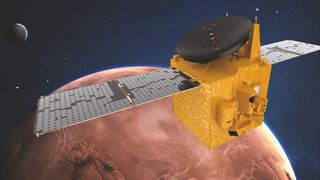The UAE's Hope mission is nearly to Mars, and scientists can't wait
"We're just counting down the final few days before we arrive to the Red Planet."

With less than two weeks before the country's first-ever interplanetary mission slips into orbit around Mars, United Arab Emirates scientists can't wait for the Hope orbiter's arrival.
The UAE launched Hope in July 2020, one of three missions taking advantage of an optimal window to head to the Red Planet, along with China's Tianwen-1 mission and NASA's Perseverance rover. Hope is an orbiter designed to study the atmosphere of Mars around the planet and from surface to space. The mission will conduct its Mars orbit insertion maneuver on Feb. 9 beginning at about 10:30 a.m. EST (1530 GMT).
"Right now, the team has prepared as well as they can possibly prepare to reach orbit around Mars," Sarah Al Amiri, chairperson of the UAE Space Agency, said during a news conference held virtually yesterday (Jan. 28). "We're just counting down the final few days before we arrive to the Red Planet."
Related: The United Arab Emirates' Hope mission to Mars in photos
Fewer than half of Mars missions attempted to date have succeeded. In advance of the risky maneuver, which will involve Hope firing its thrusters for nearly half an hour to slow down enough to slip into orbit around Mars, the spacecraft is in excellent condition, mission personnel said.
"We are fortunate to have a very healthy spacecraft, and everything is looking very good at the moment," Pete Withnell, Hope program manager at the University of Colorado's Laboratory for Atmospheric and Space Physics program, which partnered with the UAE on the mission, said during the news conference.
"I'm optimistic; that would be my primary emotion right now," Withnell said. "But I can tell you many of the team are waking up at two o'clock in the morning in a cold sweat just thinking and rethinking about aspects."
Get the Space.com Newsletter
Breaking space news, the latest updates on rocket launches, skywatching events and more!
If all goes smoothly on Feb. 9, the UAE will notch a major accomplishment, becoming just the fifth entity to successfully reach Mars, after NASA, the Soviet Union, the European Space Agency and India. (China may follow fast on the UAE's heels; the nation's Tianwen-1 mission will complete its own Mars orbit insertion a day after Hope does.)
Before beginning the Hope mission, the UAE's space experience was limited to satellites in Earth orbit; the nation's first astronaut spent a week on the International Space Station in the fall of 2019. But in 2017, the country launched a century-scale Mars-focused initiative meant to build an oil-free economy and bulk up the nation's technical sector.
Related: The UAE wants to rewrite what we know about weather on Mars
The UAE designed the Hope mission's science goals in conjunction with the international community and built international partnerships, particularly with the University of Colorado, to complete the spacecraft, then hired a Japanese Mitsubishi Heavy Industries H-IIA rocket to execute the launch on July 19.
Hope is meant to spend one Martian year, or nearly two Earth years, studying the Red Planet; that timeline will begin in May. During the mission, the spacecraft will orbit high over the planet's equator to study the weather at the surface and how the layers of the planet's atmosphere interact.
Even as Hope was making the long trek out to Mars, the UAE announced its next mission beyond Earth orbit. In 2024, the nation intends to launch its first lunar rover, Rashid, which will focus on developing and evaluating space exploration technologies. As with the Hope mission, the UAE will contract out Rashid's launch rather than develop its own rocket technology.
But for the Hope team, the focus is all on Mars and all on the challenges of arriving safely.
"I think everyone on the mission understands the emotional roller coaster," Al Amiri said. "Every point of celebration is followed by several points of worry, waiting for the next point of celebration."
"I wish I could put it into words, but I'm probably every feeling that you can possibly think, both positive, negative and neutral."
Email Meghan Bartels at mbartels@space.com or follow her on Twitter @meghanbartels. Follow us on Twitter @Spacedotcom and on Facebook.
Join our Space Forums to keep talking space on the latest missions, night sky and more! And if you have a news tip, correction or comment, let us know at: community@space.com.

Meghan is a senior writer at Space.com and has more than five years' experience as a science journalist based in New York City. She joined Space.com in July 2018, with previous writing published in outlets including Newsweek and Audubon. Meghan earned an MA in science journalism from New York University and a BA in classics from Georgetown University, and in her free time she enjoys reading and visiting museums. Follow her on Twitter at @meghanbartels.
